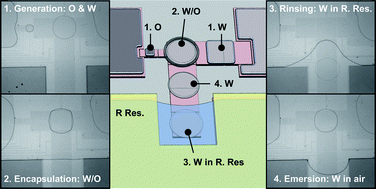A water-core and oil-shell encapsulated droplet exhibits several advantages including enhanced fluidic manipulation, reduced biofouling, decreased evaporation, and simplified device packaging. However, obtaining the encapsulated droplet with an adjustable water-to-oil volume ratio and a further removable oil shell is not possible by reported techniques using manual pipetting or droplet splitting. We report a parallel-plate device capable of generation, encapsulation, rinsing, and emersion of water and/or oil droplets to achieve three major aims. The first aim of our experiments was to form encapsulated droplets by merging electrowetting-driven water droplets and dielectrophoresis-actuated oil droplets whose volumes were precisely controlled. 25 nL water droplets and 2.5 nL non-volatile silicone oil droplets with various viscosities (10, 100, and 1000 cSt) were individually created from their reservoirs to form encapsulated droplets holding different water-to-oil volume ratios of 10 : 1 and 2 : 1. Secondly, the driving voltages, evaporation rates, and biofouling of the precise encapsulated droplets were measured. Compared with the bare and immersed droplets, we found the encapsulated droplets (oil shells with lower viscosities and larger volumes) were driven at a smaller voltage or for a wider velocity range. In the dynamic evaporation tests, at a temperature of 20 ± 1 °C and relative humidity of 45 ± 3%, 10 cSt 10 : 1 and 2 : 1 encapsulated droplets were moved at the velocity of 0.25 mm s−1 for 22 and 35 min until losing 16.6 and 17.5% water, respectively, while bare droplets followed the driving signal for only 6 min when 11.4% water was lost. Evaporation was further diminished at the rate of 0.04% min-1 for a carefully positioned stationary encapsulated droplet. Biofouling of 5 μg ml−1FITC-BSA solution was found to be eliminated by the encapsulated droplet from the fluorescent images. The third aim of our research was to remove the oil shell by dissolving it in an on-chip rinsing reservoir containing hexane. After emersion from the rinsing reservoir, the bare droplet was restored as hexane rapidly evaporated. Removal of the oil shell would not only increase the evaporation of the core droplet when necessary, but also enhance the signal-to-noise ratio in the following detection steps.


 Please wait while we load your content...
Please wait while we load your content...